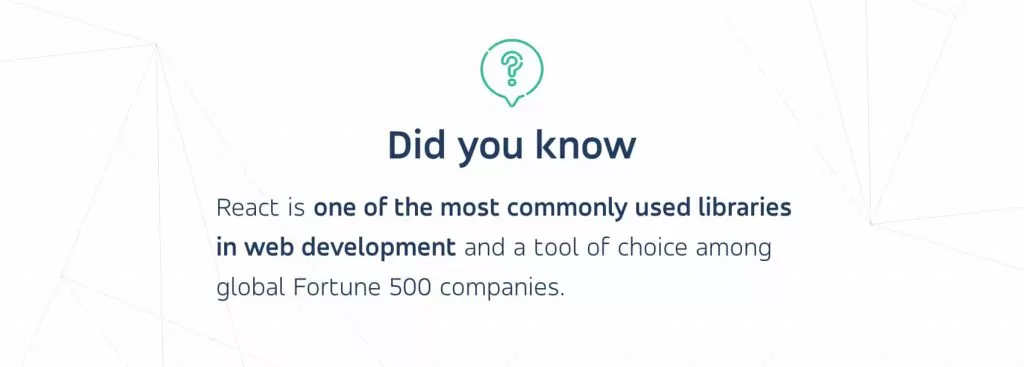React overview
Initially released in 2013 and maintained since then by Facebook and a strong community, React.js is a popular open-source front-end JavaScript library for building user interfaces. Necessity is truly the mother of invention, as its creation answered a challenge that Facebook faced with creating highly efficient and dynamic interfaces.
What made it one of the most popular libraries in this field? Hint: most probably it wasn’t the social media-related origin. So, what was it?

Why React.js?
Components and one-way data flow
React components are reusable, standalone pieces of code, similar to JavaScript functions. Nested components are the basis of React applications. Interaction between them occurs only one way, sparked by e.g. clicking an icon. Components’ state can be changed through performed actions, making an application less prone to errors, easier to debug and more efficient, as relations between elements are easier to define.
The virtual DOM
Document Object Model is a model created by the browser, each time the website is reloaded. DOM enables browsing for particular elements and altering their properties to introduce more dynamic elements. On the downside, using extensive DOMs is CPU intensive and burdens the browser, as the whole HTML tree is reloaded each time an element is changed. The virtual DOM represents HTML elements behind websites and applications. Keeping the virtual DOM record, React doesn’t need to reload the whole model, instead of generating its virtual representation, comparing elements and making changes in DOM only in those requiring updates. This enables hot reloading (real-time interface reloads) and improves applications’ efficiency.
React Hooks
Hooks are a function in React that “hook into” lifecycle features of React components, letting developers use function components in most cases that used to require class components.
This enables access to components’ lifecycle functionalities, previously exclusive to class components. In pre-hooks time, function components couldn’t support more advanced logic and were excluded from most React features.
Developer tools
The dedicated browser extension for React, React Developer Tools, is available for Chrome and Firefox users, facilitating developers’ work. React DevTools provides additional React-specific tools for better design and debugging. Developers can examine individual components in the virtual DOM, edit their state and properties, and improve the applications’ efficiency and security.
JSX
React’s sidekick, JSX, is a JavaScript Extension Syntax. JSX simplifies writing in HTML, converting mock-ups and adding them to React. By using JSX, developers gain a tool for creating their own components to answer particular needs, resulting in customized, high-volume applications.
React Native
React Native is a cross-platform framework created by Facebook for efficient mobile application development. It is widely used by developers creating apps for the most popular operating systems, combining React.js and native platforms features. React Native emerged two years later than React.js, as a response to the rapidly growing mobile development market. Users globally are turning mobile, and missing the opportunity to fully adapt websites to various devices can cause irreversible damage to business results. Incorporating React Native enables preserving app relevance through increased flexibility, live reload, great performance, and intuitive architecture. Building cross-platform applications for the most popular operating systems, reusing code and methodology from React-build applications made it easy for developers, resulting in time savings and improved mobile user experience.

Test-Driven Development
Test-driven development is a software development approach aimed at automating software testing, enabling building more stable, reliable, and safe applications. Incorporating TDD practices in React.js projects, developers can create convenient test suites and reduce redundancies in the code, achieving higher test coverage, a better, less prone to errors architecture, and shortening time-to-market.
Progressive Web Apps (PWA)
Intended to work on every device using standard browsers, progressive web applications are built with common technologies (HTML, CSS, JavaScript). What distinguishes them is the progressive feature, meaning enhancing user experience based on browser capabilities. PWA is a term describing the particular approach to app design and development, utilizing the newest technologies to improve user experience, as long as the user’s browser is capable of supporting them.
The term includes 9 core characteristics, defined by the Google Chrome engineer who introduced it in 2015, among which are: remaining up-to-date, responsiveness (adjusting to various screen sizes) and safety. The PWA approach leads to building efficient, responsive applications that look, feel and behave great, contributing to user’s satisfaction. React.js, equipped with developer tools and other add-ons, facilitates PWA development to bring out the best from the code for mobile web app users.
Maturity and stability
Being present for a few years already, React matured and became a reliable tool. Each successive release fixed issues previously hampering work, proving how well it is maintained and ready for large-scale projects.
The relatively low entry threshold
React.js is a welcoming tool for users of JavaScript-related languages, enabling them to swiftly master the library. Starting work with React.js is possible even with a relatively small knowledge base, as users can hone their skills as the project develops. Hiring frontend developers who master React.js or adopting the library among existing teams is fairly easy, as the technology ranks among the most eagerly used tools.
The community behind it
Apart from React.js features making it a user-friendly tool with a simple syntax, one of its advantages is the active, supporting community behind it. React users and developers contribute to the library’s growth, creating one of the biggest online communities gathered around technology, providing support and solutions to the most commonly encountered issues. The community-supported library is more resilient to issues, and its daily use is secured by extensive expertise.
Is it worth it, after all?
React’s popularity didn’t come out of the blue. Being fast, relatively simple and scalable, the library became a tool of choice among many Fortune 500 companies. LinkedIn, Apple, and Udemy are just a few of the companies building their services with React. The global usage among websites and market position in terms of traffic and popularity is still growing. Forecasts for the next few years are optimistic, as the demand for React.js powers isn’t coming to an end anytime soon. The library is far from being a silver bullet, but its advantages justifiably made React a huge player in web development.
Providing features aimed at simplifying web development, React.js ensures faster rendering, improves the process of building components, streamlining overall productivity and contributing to easier maintenance of written code. From the business’ point of view, React comes with a number of advantages, resulting in better UI/UX, faster development, more user- and search engine-friendly features, contributing to better market results.





